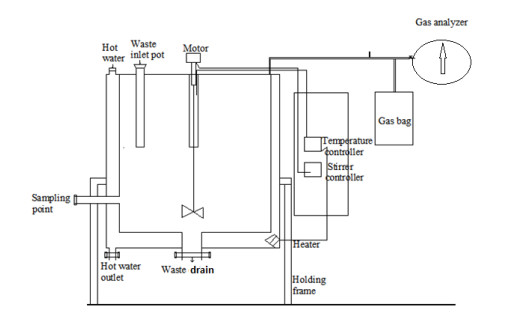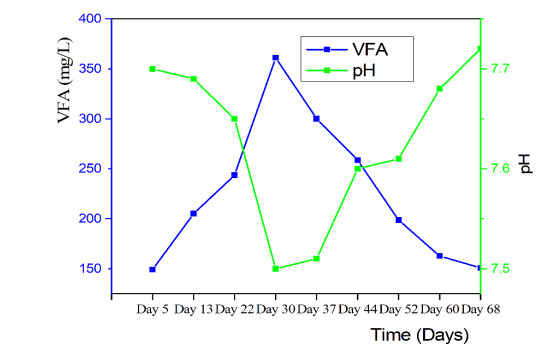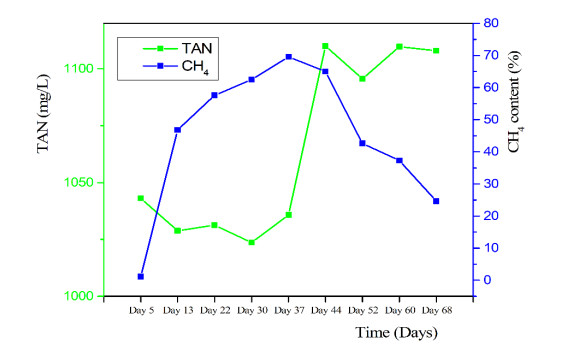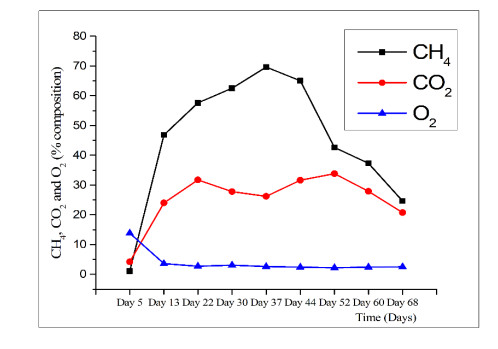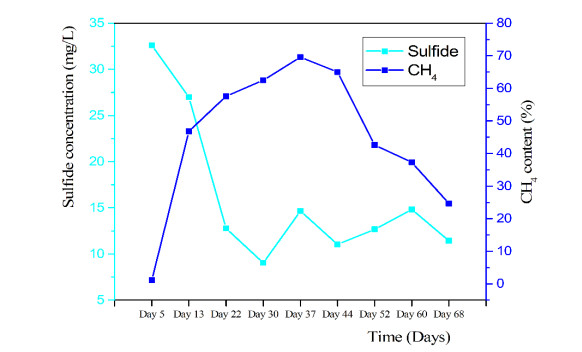The performance of experimental batch-reactor loaded with slaughterhouse waste at mesophilic temperature was investigated as well as the inhibition of both ammonia and sulfide concentration in the aqueous phase. The digester was operated for 68 days by evaluating the process stability basing on controlling parameters such as pH, volatile fatty acids and alkalinity in relation to the methane produced. The maximum CH4 content of 69.6% was achieved at 0.37 VFA/Alkalinity ratio and pH of 7.51 during day 37 of anaerobic digestion. However, a sudden increase of ammonia nitrogen in the digester from day 44 to day 68 decreased the methane content about 62.15% from 65% to 24.6%. Similarly, as the amount of sulfide content decreased in the liquid phase, gaseous H2S was elevated up to 132 ppm in the 68th day. During this time, it was observed that the ratio of VFA/Alkalinity decreased to 0.16, with a very low concentration of VFA, which was 150.92 mg/L. This phenomenon indicated that all the acids produced were consumed by methanogens and ammonia inhibition was at the highest rate due to the increase of ammonia nitrogen concentration in the last days of digestion. Furthermore, among of peculiar characteristic shown by slaughterhouse waste is the ability to maintain the pH above 7 without the addition of any buffering agent throughout the AD process. Meanwhile, the evaluation of the level of both ammonia and sulfide in the aqueous phase revealed that the inhibitory effect of ammonia concentration was higher than sulfide concentration.
1.
Introduction
The world’s dependence on fossil fuels as the main source of energy has triggered the evolution of new innovations in science and technology by researching on other simple and most affordable sources of energy [1]. This is due to the fact that the depletion of fossil fuels is imminent, but also the ecosystem has been endangered whenever these fossil fuels are burnt to release energy which is accompanied with unfriendly gases released to the atmosphere and subjecting the whole ecosystem to pollution [2]. One of the solutions is anaerobic digestion (AD) process through which biogas is generated when organic matter is degraded in the absence of oxygen (anaerobic digestion) [3]. In this manner, different organic wastes such as cow dung [4,5], pig slurry [6,7], slaughterhouse waste [8,9], tannery wastewaters [10], industrial effluents [11] and domestic wastes [12] can be treated as potential substrates to initiate the anaerobic digestion (AD) process due to the higher ratio of carbon content present in such substrates. Generally, slaughterhouse waste is characterized by high organic content mainly composed of animal fats and protein components of blood [9,13]. Since animal protein is composed of cysteine and methionine which are sulfur containing amino acids, a combination of both cysteine + methionine (sulfur amino acids) and other essential amino acids compose a complete structure of the animal protein [14]. Apart from several desulfuration reactions which catabolize cysteine to release sulfur in a reduced oxidation state, further degradation of this animal protein also releases both sulfur and ammonia into the aqueous environment which are regarded as inhibitory to the methanogens responsible for the methanogenesis process which is vital stage for producing methane during AD process [15]. Besides the high carbon and organic content of the slaughterhouse waste, large amount of waste from meat industries is also produced which need to be regulated for protecting the environment against the spread of Bovine Spongiform Encephalopathy (BSE) [16], a common disease that affects cattle. In Tanzania, a lot of waste is also produced daily from meat industries since beef cattle accounts for more than 50% of the meat produced for human consumption [17]. Therefore, anaerobic digestion of slaughterhouse waste can be regarded as a cost effective solution to lower the environmental effects posed out by the waste and also producing biogas which can serve as energy source for domestic use.
Nevertheless, the stability of the digester’s performance is highly affected by changes of parameters which may lead to inhibition and process failure. For instance, [18] showed that in a combined presence of both NH3 and H2S at lower concentrations, there is a high inhibition which affects the methanogenesis process.
The purpose of this study was to investigate among the two inhibitors, which one exceeds the recommended concentration in the liquid phase leading to inhibition process between sulfide (S2-) and ammonia (NH3). The inhibition was evaluated by monitoring the reactor’s performance at mesophilic temperature using the slaughterhouse waste as a substrate for AD process. The evaluation was done using parameters like pH, volatile fatty acids (VFA), alkalinity, ammonia-Nitrogen, sulfide and methane content produced.
2.
2.Materials and methods
2.1. Collection of substrates and inoculums
The slaughterhouse waste used in this experiment was a liquid mixture of the rumen, the content of the intestine and blood discharged from a slaughterhouse owned by the Arusha Meat Company Limited in Arusha, Tanzania. The waste collected was then inoculated with 10% of cow dung w/v which was obtained from cattle keeper residing nearby the NM-AIST and then the mixture was fed to the 10 litres batch-reactor capacity for biogas production. This batch-reactor was operated at 37 ℃ temperature, monitored daily for quantification of biogas produced and measurement of different parameters such as pH, sulfide concentration, ammonia nitrogen and VFA and alkalinity. These parameters were analyzed from 200 mL of a sample taken from the reactor after every seven days. The properties of the waste are shown in Table 1.
2.2. Analytical methods
The standard methods for wastewater examination [19] were used to determine the quantity of both total solids (TS) and volatile solids (VS). Chemical oxygen demand (COD) was measured with a HACH DR2800 instrument (HACH, Loveland, CO) using HACH digestion solution vials for high range COD (20 mg/L to 1500 mg/L) following the manufacturer’s protocol [20]. Biological oxygen demand (BOD5) was also measured using the oxitop method in which the stored values were quantified in mg/L after 5 days. Each measurement for both COD and BOD was analyzed in triplicate. Also, volatile fatty acids (VFA) and alkalinity concentrations were monitored by the modified titration methods of Ripley and Kapp [21]. The pH of the samples was measured using a VWR symphony pH meter. The concentration of total ammonia was measured by the Nessler method [22] while the concentration of sulfide was measured using the methylene blue method [23]. Gas composition was determined using biogas analyzer i.e Geotec Biogas 5000. The total ammonia nitrogen (TAN) was calculated as the summation of concentrations of both unionized (NH3‒N) and ionized (NH4+) forms of ammonia, given by the formula below:
2.3. Digester system and operation
The digester of 10 litres capacity was constructed using stainless steel materials (Figure 1). The digester was equipped with a 40 rpm stirrer and water jacket for temperature control. Inside the water jacket, temperature sensors were immersed in which the mesophilic condition was set at a temperature of 37 ℃. Also, an outlet gas pipe was fixed at the top of the digester which was connected with a collecting gas bag and thereafter the composition of the gas was measured by using a gas analyzer (Geotec Biogas 5000).
3.
Results and discussion
3.1. Digester’s performance
The performance of the digester was evaluated by considering the characteristics of the waste which was undergoing anaerobic digestion for the duration of 68 days in relation to the biogas produced. The accumulation of volatile fatty acids (VFA) and alkalinity as indicated in Table 1, there was a variation from day 1 to day 30 (29 days) in which there was an increase in VFA level from 149.15 mg/L to 361.23 mg/L equivalent to 57.53% increase. In contrast, there was a slight decrease in pH from 7.7 to 7.51. The reduction in pH didn’t reach below 7 which is the minimum requirement for digester’s stability and methanogenic activity, and that’s why the alkalinity level didn’t drop to affect the whole digestion process [25]. The high level of VFA increase in the first 29 days (51.4%), shows that it was during the process of acidogenesis in which the organic matter was being degraded to acids and alcohols which are regarded as a source of food for microorganisms.
Meanwhile, in the last 30 days, the VFA level decreased from 300.18 mg/L to 150.92 mg/L equivalent to 47.72% decrease. However, the first five days were for acclimatization of the microorganisms in the digester during the hydrolysis stage in which the organic matter is being hydrolyzed by enzymes to monomers for enhancing efficient digestion process by microorganisms. That is why, during this stage, the percentage of oxygen (13.8%) was higher than methane (1.1%) and carbondioxide (4.2%) as indicated in Table 2. Nevertheless, the amount of both TS and VS for influent waste was higher, specifically the VS, which signifies a high measure of the organic matter. On the other hand, the ratio between VFA and alkalinity is another potential parameter which can be used to evaluate the process stability of the digester. Results in Table 1 show that at day 13, the ratio was 0.54 but decreased to 0.37 in day 37. From day 13 to day 37, it is regarded that both acetogenesis and methanogenesis stages were in the process, by considering the increase of methane content from 46.8% to 69.6% as indicated in Table 2. This suggests that the mixture took 23 days to adapt and develop a methanogenic community. However, the higher content of methane which was obtained at day 37 (69.6%), was characterized by the decrease of VFA concentration about 300.18 mg/L, less VFA/Alkalinity ratio of 0.37, the decline in ammonia nitrogen concentration (NH3‒N) from day 13 to day 30 and optimum pH of 7.51. The reduction of VFA concentration in the first 30 days was associated with the total breakdown of organic content and adaptation of methanogens in the digester at the mesophilic temperature. The decrease in VFA is due to the fact that methanogens consume VFA produced during the fermentation stage as a substrate to produce methane [26]. From day 37 to day 44, the decrease in VFA/alkalinity ratio was an essential parameter which indicated that it influences the increase of methane content. For example, both Table 1 and Table 2 shows that in day 37, the maximum methane content was 69.5% at the VFA/Alkalinity ratio of 0.37 which is in line with the recommended threshold value of 0.3–0.4 [27]. However, a further decrease of methane content in the last 15 days from day 52 to 68 was characterized by less VFA/alkalinity ratio which was below the recommended value as indicated in Table 1 above, which stimulated the inhibition process. This trend though didn’t affect the pH of the digester. Still, it indicated that the methanogenesis process was at the end stages, justified by less methane content (24.6%), less effluent concentrations of both chemical oxygen demand (COD) and Biological oxygen demand (BOD) of 1575 and 375 mg/L respectively.
The increase of VFA in the first 28 days from day 1 to 30, as indicated in Figure 2 above, signifies that the acidogenic bacteria are actively working by degrading organic matter into VFA [28]. However, this process is a significant breakthrough which indicates that the microorganisms can survive during both acidogenesis and methanogenesis stages by utilizing intermediate products such as acetate, butyrate and lactate which are formed before VFA accumulation [29].
3.2. Ammonia inhibition
From results in Table 3, different forms of ammonia such as NH4+ and NH3‒N were analysed in the liquid phase at different interval of time, in which temperature and pH were regarded as controlling parameters. However, the concentrations of all the species were fluctuating since the pH of the waste in the digester was not constant.
The inhibition process is mostly influenced by the presence of two principal forms of inorganic nitrogen concentrations in the liquid phase (NH3, and NH4+), but free ammonia nitrogen (NH3) is considered as a potential inhibitor due to its high permeability to the bacterial cell wall [30]. Since there was an increase in pH of the digester from 7.51 to 7.72 in the last 30 days from day 37 to 68, this condition eventually elevated the level of total ammonia nitrogen (TAN) in the reactor at mesophilic temperature, because of temperature which influences the dissociation constant of free ammonia nitrogen [31].
From results on methane production, Table 3 above shows that the methanogenesis stage had acclimatized since day 13 when methane composition was 46.8% though the concentration of TAN was (1028.82 mg/L). However, during day 30, the concentration of TAN decreased to 1023.62 mg/L with a huge increase in methane composition (62.5%). Considering this trend and results reported in Figure 3, it is evident that the system performance of the digester attained its methanogenesis stage since day 13 even though the concentration of TAN was at its highest level (1028.82 mg/L) but decreased to 1023.62 mg/L in the day 30. These results have two implications; firstly it indicates that during early stages of anaerobic digestion, some amount of ammonia is beneficial for bacteria growth since the concentration of free ammonia decreased from 1043.09 mg/L to 1023.62 mg/L in 24 days. Secondly, the results imply that the decrease of inhibition level, which is associated with the decrease of TAN concentration resulted in methane increase by 25.12% from day 13 to day 30. However, there was a high accumulation of TAN from day 37 to day 44, as illustrated in Figure 3 due to further degradation of the nitrogen-rich protein components from blood mixed with slaughterhouse waste. Also, Figure 3 illustrates the trend in which methane content decreased as the concentration of TAN was increasing from day 44 to day 68. This trend showed that in the last 23 days, the methanogenesis process was approaching towards completion. Though, the increase in percentage composition of CO2 from day 37 to 52, as indicated in Figure 4 was significant for producing bicarbonate ion (HCO−3). This ion acts as a buffer for maintaining process stability and resisting more changes in pH. It is during this stage in which the system was internally buffered, and methane production rate was increased.
The carbondioxide in the digester forms a bicarbonate ion in the liquid phase through a reaction described below [32].
Although the much slower reaction may occur:
Nevertheless, the process stability and pH was maintained due to less accumulation of volatile fatty acids (VFA) in the digester, but also the performance of the digester can be described by the VFA/Alkalinity ratio which was between 0.3 and 0.4. This ratio is a good indicator which suggests that the function of the digester was good at the beginning and mid of the digestion process [33].
3.3. Sulfide inhibition
The amount of sulfide produced during anaerobic digestion is an indication of sulfate-reducing bacteria (SRB) which reduces sulfates (SO42−) present in the waste to sulfide (S2−) which is inhibitory to methanogens. The results indicated in Table 3 show the highest concentration of sulfide (32.60 mg/L), which was obtained during day 5. Similarly, the methane content was 1.1%, indicating that the SRB were outcompeting methane-producing bacteria (MPR) in the first days of anaerobic digestion. However, the decrease in pH from day 13 to 30 resulted into a decrease of sulfide concentration in aqueous solution from 27.0 mg/L to 9.01 mg/L as illustrated in Table 3 and Figure 5.
These changes also favored the increase in methane content to 57.6% during day 22 in which the sulfide concentration was reduced to 12.78 mg/L, which is equivalent to 60.79% decrease from day 5. Following the results in Table 2, the concentration of sulfide was decreasing in the aqueous phase but elevated in the gaseous form as hydrogen sulfide (H2S) in which the amount increased from 12 ppm to 119 ppm from day 5 to day 37.
3.4. Ammonia and sulfide interaction
From literature, it has been stated that for stable methanogenesis process, the concentration of H2S in the liquid phase should not exceed 150 mg/L [34]. In contrast, the concentration of total ammonia nitrogen (TAN) above 1,500 mg/L becomes inhibitory to methanogens [35]. Meanwhile, from the literature [36] it is revealed that TAN concentration from the digestion of slaughterhouse waste in the range of 1000–12000 mg/L can lead to inhibition. This level of inhibition is equivalent to (600 mg NH4+-N/L) at 38 ℃ and pH of 8.1. Therefore, from the experimental results of this study, it is evident that during anaerobic digestion of slaughterhouse waste at mesophilic scale, the inhibition process in the liquid phase was mostly caused by ammonia than sulfide.
4.
Conclusions
This research has demonstrated that when slaughterhouse waste is treated as a substrate during the AD process, the digester performance can maintain the methanogenesis stage even at the high TAN level. For example, when TAN concentration was 1110.08 mg/L, methane composition was 65% at a pH of 7.6. This is different from other researchers’ findings with different substrates at the same conditions. For instance, the best performance of the digester treated with high solids substrate was recorded when TAN concentration was in the narrow range of 600 to 800 mg/L [37]. However, the other study in which methane production pathways at mesophilic temperature were analyzed by comparing with the TAN concentration in a range of 0.14–9 g/L, it was observed that 200 mg/L of TAN concentration affected methane production pathways as a result of total inhibition [38]. In this study, it is evident that slaughterhouse waste can resist the inhibition process at a high TAN level by increased methane production. This is due to the fact that the pH of the substrate did not drop below 7 throughout the AD process, a condition which could lead to severe stress for microorganisms in the reactor. In addition, this phenomenon can be regarded as a major breakthrough for biogas production using slaughterhouse waste, since it doesn’t require any buffering agent. Generally, the pH range between 7–8.2 is regarded as an average range for increasing methane production and tolerant to ammonia inhibition [39].
Nevertheless, a high amount of sulfide accumulation in the first days is a sole indicator that sulfur-reducing bacteria (SRB) were very active in the first days because sulfate reducers tend to outcompete methane-producing bacteria (MPB) by oxidizing molecular hydrogen when COD value is high. Despite the fact that competition between SRB and MPB can bring about inhibition process which lower the percentage composition of methane, ammonia and sulfide concentrations are mostly considered as inhibitory parameters in the liquid phase as a result of protein degradation during anaerobic digestion. Results from this study revealed that the amount of ammonia accumulating in the digester exceeds the recommended values. However, after comparing these results from various literature, it can be concluded that the amount of sulfide accumulated was at the level which can be tolerated by methanogens. Therefore, the inhibition process in the aqueous phase during this study was due to the high level of ammonia accumulation and not sulfide, since excess sulfide in the liquid phase was being converted to gaseous H2S as the pH decreased.
Acknowledgement
The authors would like to acknowledge the African Centre of Excellence through WISE (Water Infrastructures and Sustainable Energy)—Futures Project at The Nelson Mandela African Institution of Science and Technology (NM-AIST) for financial support.
Conflict of interest
The authors declare no conflict of interest.









 DownLoad:
DownLoad:
